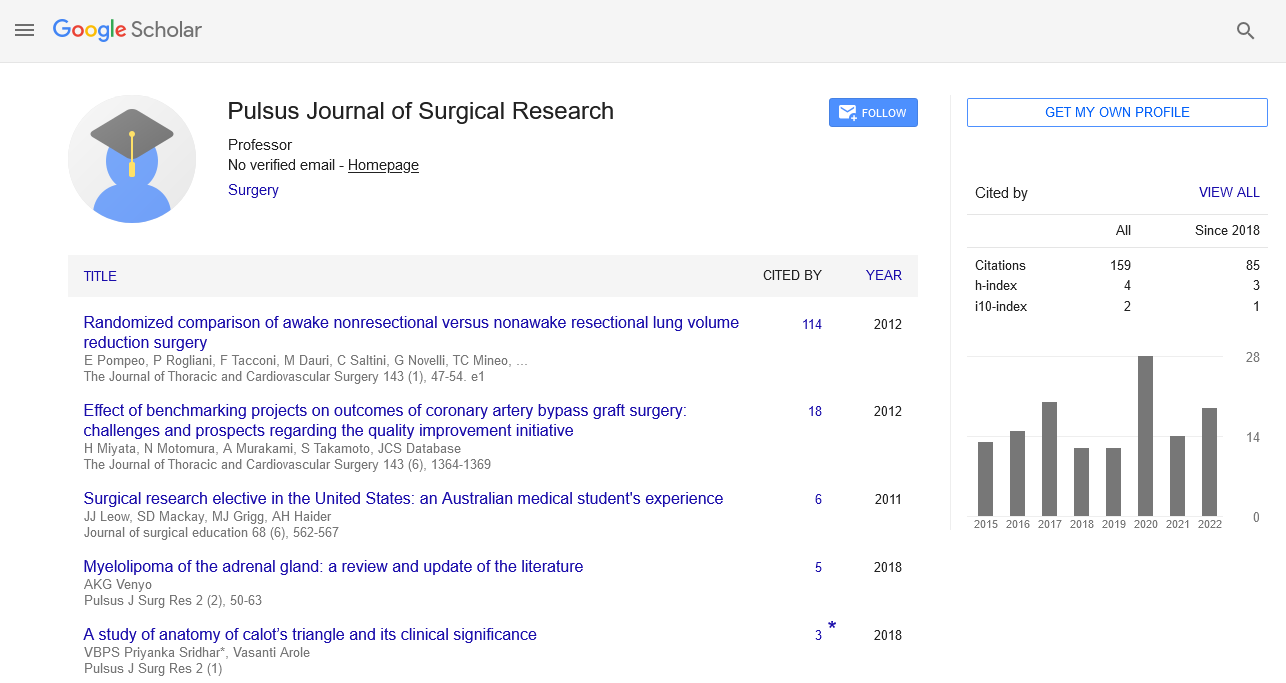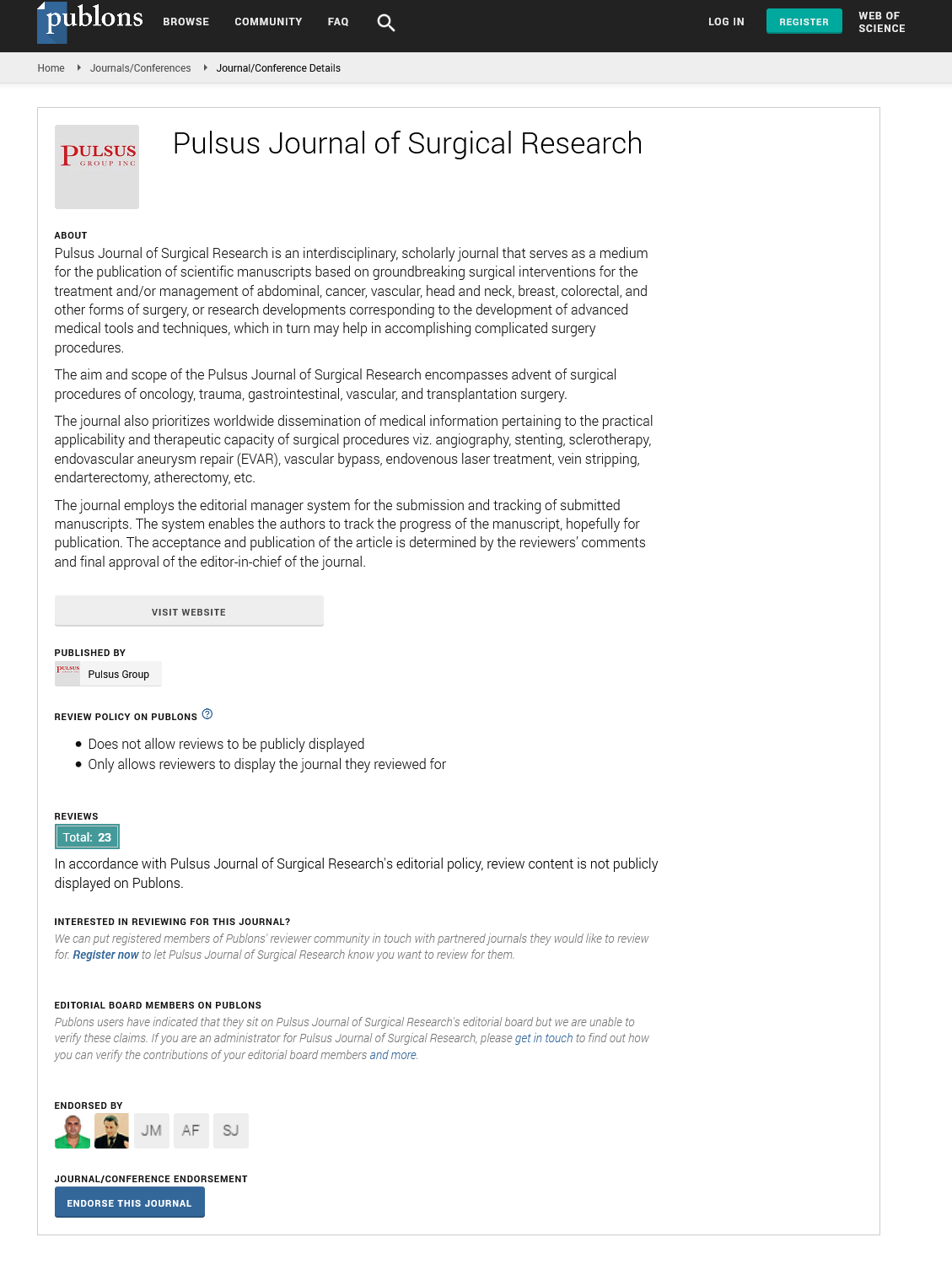Before and after bariatric surgery, the prevalence of alcohol use disorders
Received: 03-Apr-2022, Manuscript No. pulpjsr- 22-5703; Editor assigned: 06-Apr-2022, Pre QC No. pulpjsr- 22-5703 (PQ); Accepted Date: Apr 26, 2022; Reviewed: 18-Apr-2022 QC No. pulpjsr- 22-5703 (Q); Revised: 24-Apr-2022, Manuscript No. pulpjsr- 22-5703 (R);; Published: 30-Apr-2022
Citation: Thomas SS . Before and after bariatric surgery, the prevalence of alcohol use disorders. J surg Res. 2022; 6(2):25-27.
This open-access article is distributed under the terms of the Creative Commons Attribution Non-Commercial License (CC BY-NC) (http://creativecommons.org/licenses/by-nc/4.0/), which permits reuse, distribution and reproduction of the article, provided that the original work is properly cited and the reuse is restricted to noncommercial purposes. For commercial reuse, contact reprints@pulsus.com
Abstract
Reviews that particularly address alcohol usage are few despite a growing body of information on the intricate bidirectional link between ADHD and substance use. Genes implicated in glutamatergic and catecholaminergic neurotransmission are shared by both ADHD and AUD. ADHD causes’ risky behavior and unpleasant life events, creating a genetically higher risk for alcohol use disorders (AUD). Up to 43% of people with ADHD acquire an AUD; in adults with AUD, ADHD occurs in roughly 20% of cases but is incredibly underdiagnosed and under-treated. Impulsive judgments and a dysfunctional incentive system make people with ADHD susceptible to alcohol use. Therefore, regular screening and therapy processes must be used in AUD treatment. ADHD in people with AUD may be treated with long-acting stimulants or non-stimulants. But it's essential to treat AUD, other comorbid diseases, and ADHD medically while also providing medication and psychotherapy for AUD. To avoid bad results, it is crucial to identify those who are at risk for AUD, especially those who also have ADHD, conduct disorder, or oppositional defiant disorder.
Key Words
Myxoma; Adolescent; Obesity; Anomia; Odontogenic; Primordial.
Introduction
A Frequent neuropsychiatric illness is attention deficit Ahyperactivity disorder (ADHD). According to Thomas et al. (2015), 2.8% of adults and 7.1% of children and adolescents have ADHD. However, since DSM-5 is the only official diagnostic manual that includes criteria for ADHD in adults and DSM-5 lowered the symptom threshold for adults, the prevalence of ADHD in adults according to DSM-5 is quite likely to be higher than studies using previous DSM or ICD-10 criteria, which were used in previous studies. The behavioral signs of ADHD include emotional lability and dysregulation in addition to issues with attention, hyperactivity or restlessness, and impulsive decision-making. ADHD raises the risk of a range of detrimental outcomes, including academic and professional underachievement. ADHD has a diverse clinical profile that is frequently impacted by psychiatric co-morbidity, such as substance use disorders [1]. Although studies have shown that people with ADHD have a higher risk of dying young, most often as a result of accidents, comorbid SUD further raises that risk. Accordingly, patients receiving urgent trauma care following an accident displayed a higher prevalence of ADHD, and those with ADHD were considerably more likely to be under the influence of alcohol or other drugs. Pharmacotherapy for ADHD is efficient and secure, and it also works better than pharmaceutical treatment for many other psychiatric and general medical conditions [2]. According to the World Federation of ADHD International Consensus Statement, taking medication for ADHD lowers many of the negative outcomes that are frequently linked to the disorder, including "accidental injuries, traumatic brain injury, substance abuse, smoking, educational underachievement, bone fractures, sexually transmitted infections, depression, suicide, criminal activity, and teenage pregnancy." On a group level, stimulants (such as amphetamines and methylphenidate) are more effective than non-stimulants (such as atomoxetine, guanfacine, and clonidine). However, each ADHD patient will require a unique and long-term treatment plan, given that the severity of their symptoms and how they affect their daily functioning may change over time [3]. In addition to administering medication or a placebo, placebo-controlled studies also provide "medical management" and psychoeducation, both of which are important for enhancing treatment effectiveness and adherence. Other non-medical treatments, such as cognitive behavioral therapy, are beneficial but to a lower extent than medication, therefore they serve as a supplement to it or as an alternative if the patient is unable to take or is unwilling to take medication. Neurofeedback and other alternative therapies failed to provide any compelling benefits. However, even though stimulants are more effective, there is concern about their overuse, particularly in people with concomitant drug use disorder.
The use of drugs and substance use disorders (SUDs) are widespread globally. Alcohol is one of the most commonly used and misused drugs. Alcohol use is a major contributor to the burden of the disease since it increases mortality and has a range of detrimental social, psychosocial, and health effects (such as road accidents, violence toward others, and liver ailments) [4]. There is no safe level of alcohol use; nevertheless, as consumption rises, the likelihood of negative outcomes increases. Risky alcohol consumption patterns have several classifications, and different official agencies have slightly different meanings for some words. For instance, the National Institute on Alcohol Abuse and Alcoholism (NIAAA) in the US defines binge drinking as a pattern of alcohol consumption that results in a blood alcohol concentration (BAC) of 0.08 percent, or 0.08 g of alcohol per deciliter, or greater. According to the National Institute on Alcohol Abuse and Alcoholism (NIAAA), 2004 this equates to ingesting at least 56 g of alcohol for women and 70 g for males within 2 hours. The European Medicines Agency (EMA) defines heavy drinking days as days with total alcohol consumption of at least 40 g (for women) or 60 g (for males) (European Medicines Agency, 2010). Alcohol consumption in the binge/heavy drinking range is linked to an increased risk of negative outcomes, while the adoption of this precise cut-off point has been up for debate for some time. Only drinking behaviors that could have a detrimental psychosocial or physical consequence, that raise the possibility of developing an alcohol use disorder (AUD), or that could also be a symptom of an AUD, are covered by either definition. Contrarily, the Diagnostic and Statistical Manual of Mental Illnesses (DSM) and the International Classification of Disease (ICD) operational criteria are used to classify disorders like AUD (ICD).
A pattern of compulsive substance use despite negative consequences and a lack of control over substance use are characteristics of moderate to severe substance use disorders, or "dependence" in the ICD. Physically, when a substance intake is (suddenly) reduced, withdrawal symptoms might follow, leading to an increase in tolerance. The majority of psychotherapy therapies are still used in the treatment of alcohol use disorders to boost motivation to cut back on use and if at all feasible, maintain abstinence [5]. Pharmacological therapies vary depending on the stage of therapy: benzodiazepines are typically used to treat physical withdrawal to reduce the risk of potentially fatal consequences like delirium tremens or seizures and to improve treatment compliance. Pharmacotherapy can be used to control cravings, cut back on alcohol consumption (for example, the number of days with heavy drinking), or sustain sobriety after physical withdrawal, if withdrawal does not take place. Opioid-receptor antagonists like naltrexone, which are effective for treating all of these conditions, can be used (or nalmefene, which is only approved in Europe). According to a Cochrane review, naltrexone has a number needed to treat (NNT) of 12 for reducing excessive drinking and an NNT of 20 for abstinence. Acamprosate only increases the likelihood of abstinence maintenance with an NNT of 12, potentially acting via NMDA or GABA receptors. When alcohol is drunk while taking medication, disulfiram has a different mechanism of action since it inhibits the metabolism of ethanol, which can have unpleasant, serious, or even fatal side effects. Topiramate and varenicline are two other unapproved but potentially effective medications that primarily work to prevent binge drinking. Ketamine has recently demonstrated excellent promise in AUD [6]. It is not unexpected that there are no papers on AUD medication in people with AUD and ADHD because all medications are underused. There are several excellent publications on the intricate bidirectional interaction between SUD and ADHD, but to our knowledge, there hasn't been a thorough evaluation that focuses especially on alcohol. Cannabis, cocaine, or stimulant use disorders are the key topics covered in the majority of the literature on ADHD and SUD. For instance, in a recent comprehensive analysis, the prevalence of ADHD was assessed to be 10% (range 5-20%) in cocaine use disorder. The lifetime prevalence of any AUD in people with ADHD is up to 43%, whereas the lifetime prevalence of alcohol dependence (corresponding to moderate to severe AUD) is around 3%-11%, with adults showing higher rates than adolescents. Nevertheless, people with ADHD are also at an increased risk for AUD. Thus, up to 20% of people with AUD also have ADHD, and the co-occurrence of the two disorders is linked to a variety of additional comorbidities as well as a worse prognosis for treatment. The substantial comorbidity of ADHD with AUD is of major concern also on a community level because AUD is the second most common SUD (after tobacco) worldwide and causes significant morbidity and mortality.This is the first in-depth analysis of ADHD and AUD that, to our knowledge, covers the shared neurobiological and neuropsychological risk factors of both disorders, as well as how they interact and have a self reinforcing effect. It also summaries recent recommendations on how to identify and treat people with ADHD and AUD. The intricate relationships between AUD and ADHD, begin with a look at how the two disorders are related during adolescence and the early stages of adulthood and emphasizing their clinically significant bidirectionality. We proceed in the second section with a more in-depth examination of the different prevalent risk factors, ranging from genetics and early development (such as prenatal alcohol exposure) to traumatic events and brain injuries, common neuropsychological results, and gender-specific elements [7]. In the third and fourth sections, we go over the clinical effects of ADHD in AUD patients and mention recent international diagnostic and therapeutic recommendations.
Adolescent alcohol use decreases grey matter volumes and slows the maturation of white matter, increases attentional deficits, and worsens verbal memory, visuospatial function, psychomotor speed, working memory, attention, and cognitive control. Since ADHD already has an impact on these areas, those who frequently consume more alcohol also tend to have lower developmental and cognitive outcomes. A higher likelihood of binge drinking and marijuana use in adulthood is associated with worsening CD or ADHD symptoms such as inattention or CD symptoms such as delinquency. So, drinking alcohol during adolescence increases the chance of heavy drinking in those with ADHD, creating a vicious cycle with worse health and socioeconomic outcomes.
References
- Arcos-Burgos M, Jain M, Acosta MT, et al. A common variant of the latrophilin 3 gene, LPHN3, confers susceptibility to ADHD and predicts effectiveness of stimulant medication. Mol psychiatry. 2010; 15(11):1053-66.
- Arcos-Burgos M, Vélez JI, Martinez AF, et al. ADGRL3 (LPHN3) variants predict substance use disorder. Transl psychiatry. 2019; 9(1):1-5.
- Sobande AA, Eskander M, Archibong EI, et al. Elective hysterectomy: A clinicopathological review from Abha catchment area of Saudi Arabia. West Afr j med., 2005; 24(1):31-5.
- Onah HE, Ezegwui HU. Elective abdominal hysterectomy: indicatiions and complications in enugu, eastern nigeria. Glob J Med Sci. 2002; 1(1):49-53.
- Sheth SS. The scope of vaginal hysterectomy. European Journal of Obstetrics & Gynecology and Reproductive Biology. 2004;115(2):224-30.
- Varma R, Tahseen S, Lokugamage AU, et al. Vaginal route as the norm when planning hysterectomy for benign conditions: change in practice. Obstet Gynecol. 2001; 97(4):613-6.
- Mochizuki Y, Kodera Y, Ito S, et al. Treatment and risk factors for recurrence after curative resection of gastrointestinal stromal tumors of the stomach. World j Surg., 2004;28(9):870-5.






